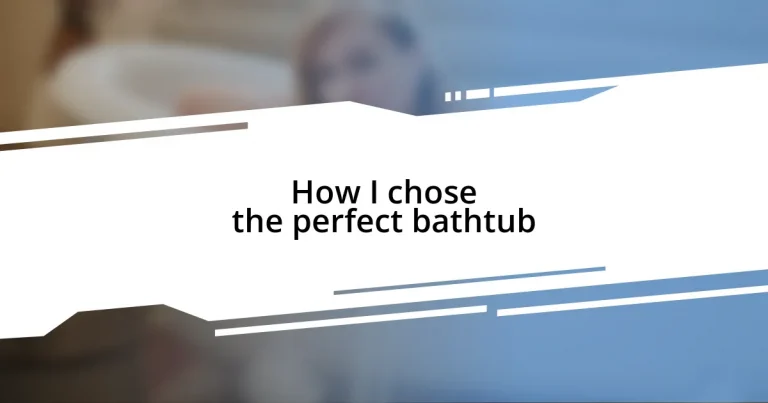Key takeaways:
- Different bathtub types (freestanding, alcove, soaking) offer varied aesthetics and functionality to create a spa-like experience at home.
- Choosing the right material (acrylic, cast iron, fiberglass) impacts durability, comfort, and maintenance, influencing the overall bathing experience.
- Establishing a budget early helps narrow down choices, with various bathtub types available at different price points.
- Design and aesthetics, including color and shape, play a crucial role in transforming a bathroom’s ambiance and enhancing relaxation.

Understanding bathtub types
When I first began exploring bathtub types, I was surprised by the vast options available. Did you know that freestanding tubs can transform your bathroom into a spa-like retreat? I remember seeing one in a showroom that just beckoned me to unwind and relax, its sleek design almost whispering, “This is where you belong.”
Let’s not forget about alcove bathtubs. They are ideal for space-saving solutions and can be quite stylish if chosen wisely. I vividly recall renovating my friend’s bathroom where we installed a beautiful alcove tub. It not only saved space but also created a cozy nook that felt inviting, making it perfect for evening soaks after long days.
Then there are soaking tubs, which prioritize depth over length to provide a more luxurious bathing experience. I once spent an entire Sunday afternoon submerged in a soaking tub, complete bliss surrounding me, alleviating the stresses of the week. Have you ever felt that moment when you descend into warm water and your worries just begin to dissolve? That’s the magic of the right bathtub type.

Evaluating bathtub materials
When I started evaluating bathtub materials, the choices felt overwhelming. Each material offers a unique blend of aesthetics, durability, and comfort, making it crucial to find the one that resonates with not just my style but also my day-to-day needs. I recall the moment I stood at a home improvement store, feeling the differences between acrylic and cast iron. Acrylic felt lightweight yet surprisingly sturdy, while cast iron had that undeniable heft and warmth that spoke of timeless elegance.
Here are some materials to consider:
- Acrylic: Lightweight and easy to install, available in a variety of styles.
- Cast Iron: Durable and retains heat well, but more challenging to install due to its weight.
- Fiberglass: Affordable but may not offer the same longevity as other materials.
- Porcelain-enamel on steel: A budget-friendly option that provides a glossy finish, but can chip and rust.
Ultimately, the feel and finish of the material can influence your bathing experience. I remember feeling the smooth, cool touch of a porcelain bathtub; it was like stepping into luxury. Each material carries its own vibe, giving you the chance to create a personal sanctuary that speaks to you.

Setting your budget for bathtubs
Setting a budget for your bathtub can feel a bit like navigating a maze, but with the right approach, it becomes much clearer. From my experience, I realized that having a defined budget helped to narrow down the options significantly. Initially, I found myself tempted by extravagant models filled with features I thought I needed, but I quickly learned to focus on what truly added value to my bathing experience rather than just bells and whistles.
As I dove deeper into my bath project, I discovered a range of price points associated with different styles and materials. For instance, I initially set aside $1,000, thinking it would cover an excellent bathtub. However, as I researched, I vividly remember reallocating funds to accommodate a high-quality acrylic tub that truly caught my eye. This little shift allowed me to purchase a product that met both aesthetic and practical needs without straining my budget.
To give you a better sense of the financial landscape, here’s a comparison of average prices for various types of bathtubs that I found during my search:
| Bathtub Type | Average Price |
|---|---|
| Alcove Tub | $300 – $1,200 |
| Freestanding Tub | $1,000 – $5,000 |
| Corner Tub | $700 – $2,000 |
| Soaking Tub | $800 – $4,000 |

Considering bathtub features and options
As I dove into the world of bathtub features, a few standout options caught my attention. One feature that really excited me was the idea of hydrotherapy jets; they evoke that spa-like experience right in the comfort of my home. I remember picturing those soothing bubbles working their magic after a long day, and I found myself daydreaming about the relaxation that would come with it.
Next, I considered the shape and size of the bathtub. There are so many styles to choose from! I was particularly drawn to freestanding tubs, as they offer a statement piece that can elevate the whole bathroom. Standing in front of different models, I felt the allure of their elegant curves, which invited me to imagine myself sinking in with a good book and a glass of wine. But I had to ask myself: would that luxurious look fit in my space without overwhelming it?
Finally, the accessibility features turned out to be quite enlightening. I hadn’t realized how much I would appreciate grab bars and slip-resistant surfaces until I started thinking about long-term usability. This became personal when I considered my loved ones; having a bathtub that accommodates everyone’s needs felt like an essential aspect of my decision. Wouldn’t it be comforting to know the entire family could enjoy a safe soaking experience? Each choice, big or small, carries a significant impact on how I could transform my bathroom into a haven tailored to my needs and those of my family.

Reviewing bathtub design and aesthetics
When I began researching bathtub designs, it was fascinating to see how various styles can completely transform a bathroom’s vibe. I distinctly remember walking through a showroom and being drawn to a sleek, modern freestanding tub that immediately made the space feel more luxurious. It sparked a realization: the right design doesn’t just look good; it makes you feel good every time you step into your bathroom.
Aesthetics also include material choices, and that’s where my personal preferences began to surface. The warmth of a wooden bathtub caught my attention, reminding me of serene spa visits. I found myself imagining how the natural texture would create a soothing atmosphere. How could that not elevate my bathing experience? Suddenly, I understood that the visual appeal was just as important as the functionality; they needed to work in harmony.
Color played a crucial role in my decision-making process, as well. I discovered how light shades could create an illusion of space and tranquility in my somewhat compact bathroom. I vividly remember imagining a soft, matte white finish that would not only reflect light beautifully but also provide a canvas for other decorative touches. It made me realize that the right palette can evoke emotions and set the mood for relaxation. What can be more essential in a bathing sanctuary than an environment that invites you to unwind?

Choosing the right bathtub installation
Choosing the right bathtub installation involves considering both the type of installation and your bathroom’s layout. When I was mapping out my new space, I had a clear vision of where I wanted the bathtub to go, but I also needed to follow the plumbing’s current structure. I found myself asking: should I opt for a built-in model that maximizes space, or a stunning freestanding tub that acts as a focal point? Ultimately, the decision came down to balance—a blend of aesthetics and practicality.
In my experience, it’s essential to think about access when planning the installation. I recall a friend who chose a luxurious soaking tub but neglected to factor in the space around it, making it impossible to move comfortably. This taught me the importance of measuring everything from doorways to the actual tub dimensions. I realized that if the installation feels restrictive, it dampens the whole bathing experience. Wouldn’t you want to create an inviting atmosphere that feels as good as it looks?
Lastly, hiring a professional for installation proved to be a game changer. I initially considered tackling the project myself, but the thought of improper sealing or misaligned fixtures made me rethink that idea. Watching the skilled contractor work effortlessly gave me peace of mind. I remember feeling relieved knowing that I wouldn’t have to worry about leaks or damage down the line. Sometimes, investing in expertise is the best way to ensure your dream bathtub becomes a reality, right?














